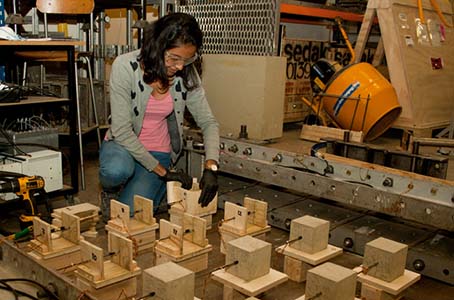Durability of CFRP pre-stressed concrete under environmental and mechanical loading
Because of its non-corrosive properties, carbon fibre reinforced polymer (CFRP) has great potential for use in environments where regular steel reinforcement would be particularly vulnerable to corrosion. However its relative newness in civil engineering applications means that there is still much to be learned about its long term performance when coupled with concrete. This is particularly important for CFRP pre-stressed concrete structures exposed to environments of high moisture, extreme heat and extreme cold.
While CFRP is resistant to corrosion, it has been observed to expand transversely due to moisture exposure. Although the short term effects of this swelling have been studied to a certain extent, the interaction of the swollen tendon with the surrounding concrete cover in CFRP-concrete structural elements is still unexplored. An additional factor to consider is the effect of external stresses on CFRP moisture uptake rates, especially important for pre-stressed CFRP tendons. Many studies have clearly shown that increasing tensile stresses cause higher moisture diffusion rates and saturated moisture uptake levels in FRPs. Through this series of investigations, it is then possible to better understand the effects of prolonged mechanical loading and moisture exposure on the overall durability of CFRP pre-stressed concrete beams. The new knowledge gained will fill gaps in the understanding of the durability issues associated with the use of CFRP in structural engineering applications.
Collaborators
The CIRG has been working with Dr Giovanni Terrasi at EMPA on CFRP prestressed high strength concrete and also durability characteristics of CFRP tendons. The support of SACAC is gratefully appreciated.
Selected Publications
| Scott, P., Toumpanaki, E. & Lees, J.M. (2022) Solution Uptake in Cylindrical Carbon-Fibre-Reinforced Polymer (CFRP) Tendons, Advances in Polymer Technology, v. 2022, Article ID 1981256, 16 pages, 2022. https://doi.org/10.1155/2022/1981256 |
| Toumpanaki E, Lees JM and Terrasi GP. (2020) Analytical predictive model for the long-term bond performance of CFRP tendons in concrete, Composite Structures, 250, 112614 https://doi.org/10.1016/j.compstruct.2020.112614 |
| Lees, J.M., Toumpanaki, E., Barbezat, M., & Terrasi, G. (2017) " Mechanical and durability screening test methods for cylindrical CFRP prestressing tendons " ASCE Journal of Composites for Construction 0.1061/(ASCE)CC.1943-5614.0000727, 04016080. (accepted version) (doi) |
| Toumpanaki, E., Lees, J.M. and Terrasi, G.P. (2015) "Shear Modulus of Cylindrical CFRP Tendons Exposed to Moisture" ASCE Journal of Composites for Construction, v. 19 (3) 10.1061/(ASCE)CC.1943-5614.0000521, 04014059 (postprint) (doi) |
| Scott, P. and Lees, J.M. (2012) "Effects of solution exposure on the combined axial-shear behaviour of unidirectional CFRP rods" Composites Part A: applied science and manufacturing v. 43A (1) pp. 1599–1611 (postprint) (doi) |


